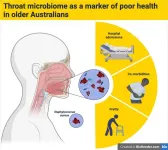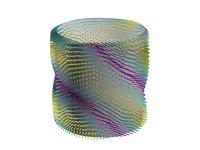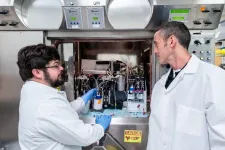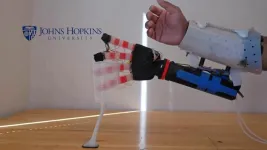(Press-News.org) By 2050, there will be 25.2 million people living with Parkinson’s disease worldwide (a 112% increase from 2021), largely due to population ageing, suggests a modelling study published by The BMJ today.
Overall, the number of people living with Parkinson’s disease (all age prevalence) per 100,000 population is predicted to increase by 76%, and by 55% when corrected for age differences (age standardised prevalence), with rates projected to be highest in East Asia.
The researchers say these projections “could serve as an aid in promoting health research, informing policy decisions, and allocating resources.”
Parkinson’s disease is the neurological disease with the fastest growing prevalence and disability, yet predictions of future prevalence in many countries and regions are still lacking.
To address this, researchers used data from the Global Burden of Disease Study 2021 to estimate the age, sex, and year specific prevalence of Parkinson’s disease in 195 countries and territories from 2022 to 2050 and the factors driving changes in Parkinson’s disease cases.
Globally, they estimate that the number of people living with Parkinson’s disease in 2050 will be 25.2 million for all ages and both sexes combined, representing a 112% increase from 2021.
By 2050, cases of Parkinson’s disease are projected to increase in all Global Burden of Disease regions, particularly in moderately developed countries in the middle range of the Socio-demographic Index (SDI) scale.
The researchers predict that population ageing will be the main driver (89%) behind this rise, followed by population growth (20%), with different patterns at the regional and national levels.
They estimate that the all age prevalence of Parkinson’s disease will reach 267 cases per 100,000 in 2050 (243 for women and 295 for men), an increase of 76% from 2021, while the age standardised prevalence is expected to rise by 55% to 216 cases per 100,000.
The largest number of Parkinson’s disease cases is predicted to be in East Asia (10.9 million), followed by South Asia (6.8 million), with the fewest cases in Oceania and Australasia.
The most pronounced increase in Parkinson’s disease cases by 2050 is expected to occur in western Sub-Saharan Africa (292%), while the smallest increases (28%) are projected in central and eastern Europe, due to negative population growth and a smaller contribution from population ageing.
People aged over 80 are predicted to have the highest prevalence (2087 cases per 100,000) in 2050, while the gap in cases between men and women is also set to widen globally from 1.46 in 2021 to 1.64 in 2050.
Finally, the researchers estimate that increasing physical activity could reduce the future number of Parkinson’s disease cases, whereas stopping smoking may lead to a rise in prevalence, but say these results should be interpreted cautiously.
As this is a modelling study, it has some important limitations, including low availability and quality of data in some regions, a lack of data on risk factors other than demographics, and being unable to accurately predict the prevalence of Parkinson’s disease in various ethnic groups, or the impact of covid-19.
However, the researchers say that to the best of their knowledge, this study provides the first comprehensive projections of the global, regional, and national prevalence of Parkinson’s disease until 2050.
“An urgent need exists for future research to focus on the development of novel drugs, gene engineering techniques, and cell replacement therapies that are aimed at modifying the course of the disease and improving patients’ quality of life,” they conclude.
In a linked editorial, researchers welcome this study but say adopting more advanced techniques may allow for better forecasting and ensure that healthcare systems, policy makers, and researchers are equipped with reliable data for long term planning.
“Future projections should prioritise methods that capture the true complexity of chronic disease progression, ultimately leading to more effective interventions and improved patient outcomes,” they conclude.
[Ends]
END
Cases of Parkinson’s disease set to reach 25 million worldwide by 2050
Substantial increase largely due to population ageing, say researchers
2025-03-06
ELSE PRESS RELEASES FROM THIS DATE:
Throat microbiome holds clues to older Australians’ health
2025-03-06
New research by Flinders University has uncovered a potential marker that could provide valuable insights into the overall health of older adults living in long-term aged care facilities.
Led by PhD candidate Sophie Miller in the College of Medicine and Public Health, the study found that a simple swab from the back of the throat, known as the oropharynx, may offer clues about health challenges faced by aged care residents.
“Our findings suggest that certain bacteria detected in the back of the throat could indicate greater health vulnerability in older adults,” says Miller.
Identifying vulnerable individuals ...
Diabetes drug could help cancer patients make better recovery
2025-03-06
A common type of diabetes medication could help cancer patients make a better long-term recovery, according to new research from the University of East Anglia.
Many cancer patients go on to develop heart failure - because of the cancer itself and also due to chemotherapy. This can lead to a reduced quality of life, multiple admissions to hospital or even death.
But a new study published today shows that a type of diabetes medication, called an SGLT2 inhibitor, may help protect the ...
Seismic study of Singapore could guide urban construction and renewable energy development
2025-03-05
A new seismic study of Singapore could guide urban growth and renewable energy development in the coastal city nation, where 5.6 million residents live within an area of 734 square kilometers.
The study, published in Seismological Research Letters, identifies areas with increased risk of ground shaking and a possible reservoir for geothermal energy production, as well as a glimpse at Singapore’s tectonic history.
Jiayuan Yao of China University for Geosciences and colleagues analyzed teleseismic data captured by a few permanent seismic stations and a nodal seismic array deployed in 2019 around the city. Their results provide the first detailed look at the top-kilometer ...
Tufts scientists develop open-source software for modeling soft materials
2025-03-05
When mechanical and structural engineers design machines, bridges, and buildings, they calculate loads, stresses, and deformation of metal, steel, concrete, glass, wood, and plastic to find the optimal geometry that bears loads with the minimum cost of material.
Designing for relatively hard materials that do not deform too much is commonly handled by software that calculates and optimizes structures using mathematical models that are well understood and easily applied.
But there is an expanding class of design challenges for things that incorporate soft materials—biological materials, engineered tissues, membranes, and even shape-shifting ...
Repurposed ALS drug becomes imaging probe to help diagnose neurodegeneration
2025-03-05
Positron emission tomography (PET) is a nuclear imaging technique used to diagnose conditions such as cancer. An innovative advance from scientists at St. Jude Children’s Research Hospital is enhancing the technique’s ability to check for signs of neurological disease. The researchers repurposed the drug edaravone, an antioxidant used to treat amyotrophic lateral sclerosis (ALS), as a probe to be used with central nervous system PET imaging. With this technique, the researchers can ...
AI can open up beds in the ICU
2025-03-05
At the height of the COVID-19 pandemic, hospitals frequently ran short of beds in intensive care units. But even earlier, ICUs faced challenges in keeping beds available. With an aging American population, 11% of hospital stays included ICU stays.
Artificial intelligence offers a possible solution, says Indranil Bardhan, professor of information, risk, and operations management and Charles and Elizabeth Prothro Regents Chair in Health Care Management at Texas McCombs. AI models can predict the lengths of time patients will spend in the ICU, helping hospitals better manage their beds and, ideally, cut costs.
But although AI is good at predicting length of stay, ...
Are robotic hernia repairs still in the “learning curve” phase?
2025-03-05
For an abdominal wall hernia repair, also known as a ventral hernia repair, the most common surgical approaches have been laparoscopic and open techniques.
But a new approach for repairing hernias has been steadily growing in popularity: the surgical robot.
Supporters of using the robot method state multiple advantages over traditional laparoscopic and open approaches, including improved surgeon ergonomics.
But there may be downsides to the technology that are going undiscussed.
In a research article published in JAMA Surgery, Brian Fry, M.D., M.S., a ...
New STI impacts 1 in 3 women: Landmark study reveals men are the missing link
2025-03-05
A landmark study reveals that bacterial vaginosis (BV), a condition affecting nearly a third of women worldwide and causing infertility, premature births and newborn deaths, is in fact a sexually transmitted infection (STI), paving the way for a revolution in how it is treated.
Monash University and Alfred Health researchers at the Melbourne Sexual Health Centre say their findings, published today in the New England Journal of Medicine, hold the key to driving down stubborn and distressing recurrence ...
Feeling is believing: Bionic hand “knows” what it’s touching, grasps like a human
2025-03-05
Johns Hopkins University engineers have developed a pioneering prosthetic hand that can grip plush toys, water bottles, and other everyday objects like a human, carefully conforming and adjusting its grasp to avoid damaging or mishandling whatever it holds.
The system’s hybrid design is a first for robotic hands, which have typically been too rigid or too soft to replicate a human’s touch when handling objects of varying textures and materials. The innovation offers a promising solution for people with hand loss and could improve how robotic arms interact with their environment.
Details about the device appear today in Science Advances.
“The ...
Damon Runyon Cancer Research Foundation awards $4.4 million to top young scientists
2025-03-05
The Damon Runyon Cancer Research Foundation has named 13 new Damon Runyon Fellows, exceptional postdoctoral scientists conducting basic and translational cancer research in the laboratories of leading senior investigators. The prestigious, four-year Fellowship encourages the nation's most promising young scientists to pursue careers in cancer research by providing them with independent funding ($300,000 total) to investigate cancer causes, mechanisms, therapies, and prevention.
The Foundation has also named ...
LAST 30 PRESS RELEASES:
Clearing the brain of aging cells could aid epilepsy and reduce seizures
Brain injuries linked with potential risk of suicide, new study finds
New technique lights up where drugs go in the body, cell by cell
New study finds movement of fishing fleets can reveal shifts in marine ecosystems
Embargoed: New evidence points to potential treatment for vascular dementia
Study uncovers disrupted brain balance in alcohol dependence
Working in groups can help Republicans and Democrats agree on controversial content moderation online
Structural findings reveal how distinct GPCR ligands create different levels of activation
Anything-goes “anyons” may be at the root of surprising quantum experiments
UC review: Maximizing workplace opportunity for veterans
From generation to complex control: Metasurfaces make perfect vortex beams "within reach"
Thin-film lithium niobate-based detector: recent advances and perspectives
Exploring why some people may tend to persistently make bad choices
How cells balance their protein levels
Nirsevimab vs RSVpreF vaccine for RSV–related hospitalization in newborns
Effectiveness and impact of maternal RSV immunization and nirsevimab on medically attended RSV in US children
AI gives scientists a boost, but at the cost of too many mediocre papers
Next-generation vision model maps tree growth at sub-meter precision
Genes aren’t destiny for inherited blindness, study shows
MIT study: High-fat diets make liver cells more likely to become cancerous
Exposure to multiple fine particulate matter components and incident depression in the US Medicare population
Risk of burdensome health care spending over time in the US
Nirsevimab against hospitalizations and emergency department visits for lower respiratory tract infection in infants
New microfluidics technology enables highly uniform DNA condensate formation
A new strategy for immune tolerance
Super Mario Bros. help fight burnout: New study links classic games to boosted happiness
Deepest gas hydrate cold seep ever discovered in the arctic: International research team unveils Freya Hydrate Mounds at 3,640 m depth.
Integrating light and structure: Smarter mapping for fragile wetland ecosystems
ACA-SIM: A robust way to decode satellite signals over complex waters
Probiotics can restore gut microbiome in breastfed infants
[Press-News.org] Cases of Parkinson’s disease set to reach 25 million worldwide by 2050Substantial increase largely due to population ageing, say researchers




